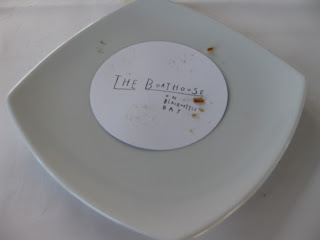My dear brother's Christmas gift to motherflap and I was to take the family to the Boathouse on Blackwattle Bay. Then she wouldn't have to cook, and I would have blog material. How thoughtful! (Can you tell who reads this blog?)
We had a booking for midday for Sunday lunch and found the doors locked at five to midday. After exploring the surroundings a little, we climbed a set of stairs at five past midday to be greeted by this view:

We decided to go with some oysters instead of the starters on offer - the waitress recommended two of the six types of oysters available as particularly good. After taking our order, we were served these complimentary appetisers:

Tomato consomme with caviar, ginger and coriander. Quite pleasant, but it was tricky to eat the caviar if you wanted to because of the way it was served.

Mmm, oysters. We tried the Hastings River Rock and Macleay River Rock varieties as recommended by the waitress - both $4.20 each. They were served with a champagne vinegarette and dark rye bread sliced extremely thinly - at first we thought the bread had been frozen and was defrosting because it had a funny cold spot in the middle, but then we worked out that the melting ice from the oyster tray was dripping down into the bread plate. Not so good. We were also served complimentary sourdough and ciabatta (which everyone gets, even if you don't order oysters).

My brother had the famous snapper pie ($48). The pie is brought to the table on a trolley and then cut up in front of you to be served with mashed potato and smoked tomatoes. This is only half the pie on the plate - a very generous serving and delicious, but quite heavy. The sauce and the pastry tasted very buttery.

Motherflap and dadflap shared the bouillabaise ($88, to be shared between two). This was also brought out on a trolley, causing much curiosity among the other diners. There were four different types of fish according to the menu (Blue eye trevalla, coral trout, John Dory and sand whiting) as well as octopus, clams and mussels - much lighter than the snapper pie, but equally delicious.

I had the Sicilian style swordfish ($41). Plenty of pine nuts and parsley, and presented in an innovative way (when I first got it, I thought "they've turned my fish into a sausage!")

Side order of chips ($12) - crisp on the outside and fluffy on the inside, and not too oily.

Mixed leaf salad ($8). Quite plain, but it helped to balance the heaviness of the snapper pie.
After finishing our mains we contemplated dessert, but unfortunately the restaurant had filled up quite a bit since midday and the waiters were being worked off their feet. After considering the dessert menu, we decided it would be more efficient to go shopping instead. Probably better for our waistlines too considering our Christmas indulgences and how generous the portions were.
A further note on the service front - there's a lot of criticism of the waiters on eatability. I thought they were very helpful but over-worked, so less attentive towards the later part of our meal. A bit worrying given the restaurant was only half to three-quarters full.
When we asked for the bill we were served some complimentary hazelnut gateaux:

Which made me regret not ordering a coffee ($5). Maybe next time.

The Boathouse on Blackwattle Bay
End of Ferry Road
Glebe NSW 2037
(02) 9518 9011
Open midday to 3pm and 6:30pm to 10:30pm, Tuesday to Sunday
More information can be found here











